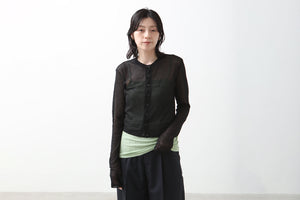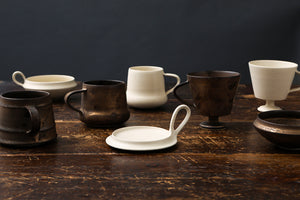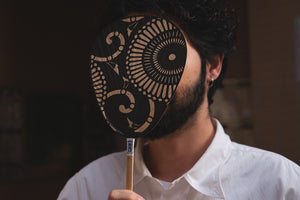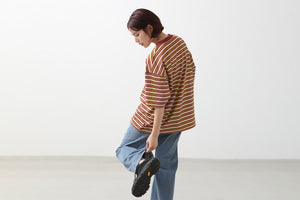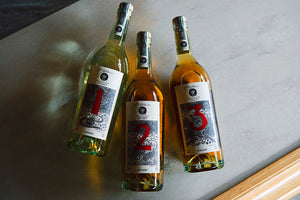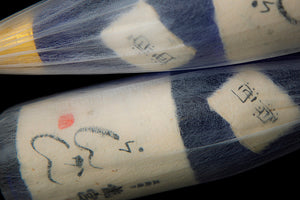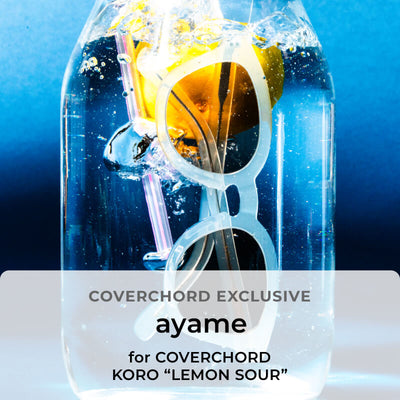FEATURE

COVERCHORD CULTURE
A Visit to Koishiwara : The Beauty of Function
Onimaru Toyoki Kiln / Oumei Pottery
Koishiwara ware is a form of pottery established in the mountains of Fukuoka Prefecture during the latter half of the 17th century. The main feature of Koishiwara ware is the patterns produced by using the edge of a blade or a brush to create markings while turning the potter’s wheel.
COVERCHORD visited Onimaru Toyoki Kiln and Oumei Pottery in Tōhō Village, Fukuoka Prefecture, to find out more about the peculiar charm of Koishiwara ware, which has been adored by the Japanese people as daily use items for more than 350 years.
Koishiwara Ware - Chikuzen’s Earliest Ceramics
Originating in 1682, when the Kuroda samurai clan invited a potter from Imari to the area, Koshiwara ware was the first pottery to be crafted in the old province of Chikuzen. Muneyoshi Yanagi, the father of the Mingei (folk art) movement, which championed everyday, utilitarian objects created by “unknown craftsmen,” deemed Koishiwara ware the ultimate in “beauty of function.” One of the main characteristics of Koishiwara ware is the techniques applied to create its distinctive patterns.
Techniques such as “Tobikanna" (flying plane), using the edge of a blade, and “Hakeme" (brush marks), with a brush, are used to create patterns while the vessel spins on the potter’s wheel. The resulting patterns are both precise and greatly symmetrical but still warm.
Koishiwara - Traditional Ceramics Hub
The Koishiwara district is located in southeastern Fukuoka Prefecture, surrounded by mountains 1,000 meters above sea level. An hour's drive from the city, the nature-rich area is now called Tōhō Village, following a merger with the neighboring township during the Heisei era.
The area is home to more than 50 potteries and represents a triumph in the continuation of traditional techniques for over 350 years.
For this piece, COVERCHORD visited two of the many studios that dot the area - Onimaru Toyoki Kiln and Oumei Pottery.
The Koishiwara area is a tranquil landscape blessed with rich resources that support its rich ceramics culture, including ample clay deposits ideal for the production of pottery and plentiful trees to fuel the kilns.
Blessed with clean sources of water source, Koishiwara’s agriculture is also thriving.

Enduring, pure Koishiwara ware
Onimaru Toyoki Kiln
While each kiln crafting Koishiwara ware is unique and has its distinct character, Toyoki Onimaru, the owner of Onimaru Toyoki Kiln is one ceramicist who earnestly carries the traditions and techniques that have been handed down to him. Born in the area, Toyoki was surrounded by ceramic culture since he was a child. After graduating from high school, he spent three years training under ceramic artist Tetsuzo Ota, before opening his first kiln in 1982. He has devoted almost 40 years of his life to crafting Koishiwara ware.
The studio is filled with the earthy aroma of clay. While seemingly reluctant to be photographed, Toyoki has a warm, gentle smile. Once he is at the potter's wheel though, there was no such bashfulness, as the heart of a craftsman who truly loves his work becomes apparent. "No matter how skilled a potter you are, you never know how it will turn out until it leaves the kiln." Toyoki claims that this is the most interesting part of his long career.
Koishiwara - Traditional Ceramics Hub
The Koishiwara district is located in southeastern Fukuoka Prefecture, surrounded by mountains 1,000 meters above sea level. An hour's drive from the city, the nature-rich area is now called Tōhō Village, following a merger with the neighboring township during the Heisei era.
The area is home to more than 50 potteries and represents a triumph in the continuation of traditional techniques for over 350 years.
For this piece, COVERCHORD visited two of the many studios that dot the area - Onimaru Toyoki Kiln and Oumei Pottery.
A father and son work side by side on the potter's wheel. The red clay used to make the pottery comes from the nearby mountains.
Onimaru Toyoki Kiln is run by the family.
While many traditional Japanese crafts are facing a shortage of new blood, many young people in their 20s and 30s can be found working in Koishiwara ware. One such person is Toyoki’s son, Kimine, who has been studying under his father’s guidance since 2010 and will eventually become tasked with leading the kiln into the future. While Kimine's modern sensibility is important, the techniques and underlying philosophy that Toyoki himself has cultivated are also being carried over.
When I asked him what he values most Toyoki replied, "To never change. To keep making things.” With the spread of the Internet, he says that he is a little perplexed by the fact that his pottery ends up in the hands of people he has never met, but no matter the times, he has vowed not to deviate from his focus on sincerely crafting his ceramics. Although they follow traditional methods, Toyoki’s work is by no means outdated and has its own unique, eye-catching presence. It makes one think, perhaps individuality is not something that needs to be added, but something to be refined through persistence and perseverance.
ONIMARU TOYOKI KILN
Address: 900-2 Oaza Koishiwara, Tōhō Village, Asakura-gun, Fukuoka, Japan
Instagram_@toyokigama
Onimaru Toyoki Kiln

A new tradition of Koishiwara Ceramics
Oumei Pottery Co.
Oumei Pottery was founded in 1983 by Oumei Onimaru and is currently helmed by his son, Naoyuki Onimaru. Growing up immersed in the world of pottery, it was a natural progression for the Naoyuki to follow in his father's footsteps. After attending Tokyo University of the Arts, Japan’s most prestigious art school, he returned to Koishiwara with his wife, Akiko, in 2009.
He says that there are many charms of Koishiwara ware that he rediscovered living away from his hometown and its famed ceramics culture. As the second generation of Oumei Pottery, his goal is to use new creative means to share its charms with the world.
While following the traditional methods inherited from his father, Naoyuki's modern style, reminiscent of contemporary Scandinavian aesthetics, has been well received by the younger generation. Koishiwara's high-quality, iron-rich clay, is ideal for his distinctive matte textures, a style that suits modern lifestyles emphasizing both utility and aesthetic value. His pieces are truly daily-use items that embody the "beauty of function." "I feel that the recognition of Koishiwara ware has definitely grown in the past 10 years. Before, people used to ask me, 'Is this Oshikada ware?” (laughs)
Naoyuki at the potter's wheel.
The slimy clay gradually takes form in his hands.
It is as if he is taming life.
To get their Koishiwara ware into the hands and lives of more people, the family and staff at Oumei Pottery carefully oversee all stages from sourcing the clay to displaying the finished products. Naoyuki assigns different stages of production to different members of the team to ensure efficiency and the best quality product possible.
As an artist who frequently showcases his work around Japan, Naoyuki makes an effort to take what he learns from the wider ceramics world and incorporate it into his work, while also passing it on to the next generation of Koishiwara ware makers. Similarly, the respect Naoyuki has for his father, Oumei, and his determination to further refine his skills is palpable. “My skill level is different from that of my father. His movements are slow, but his finishing speed is much faster. I still have a long way to go."
Glazing is done at a brisk pace by a three-man team and then taken to the kiln.
There are infinite blends of glazes, with silica stone, limestone, and natural ash comprising the main ingredients.
Vessels are piled high until the kiln is full while taking meticulous care to prevent the pieces from touching each other.
Oumei Pottery
Address_1126-1 Koishiwara, Tōhō Village, Asakura-gun, Fukuoka, Japan
Instagram_@oumei_kamamoto
Instagram_@oumei_kamamoto




